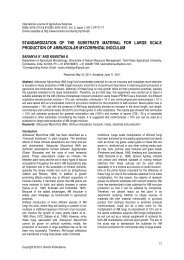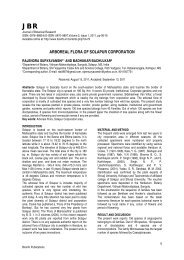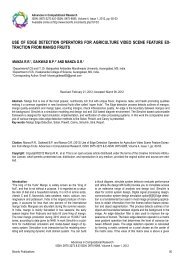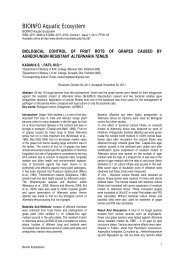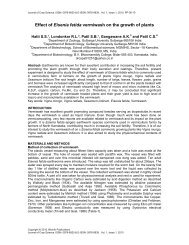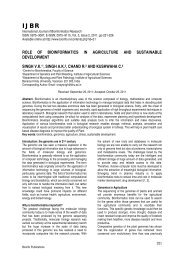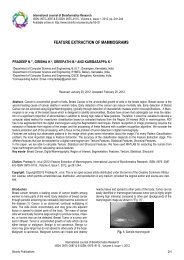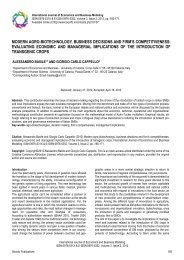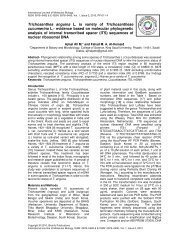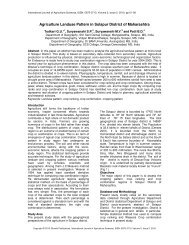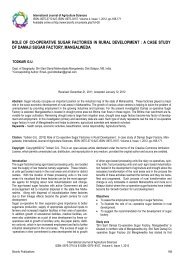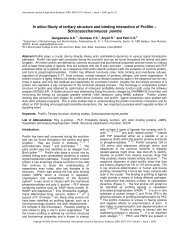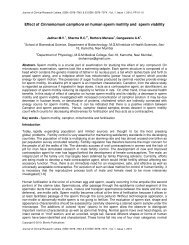automation using 8051 microcontroller and rc5 remote - Bioinfo ...
automation using 8051 microcontroller and rc5 remote - Bioinfo ...
automation using 8051 microcontroller and rc5 remote - Bioinfo ...
Create successful ePaper yourself
Turn your PDF publications into a flip-book with our unique Google optimized e-Paper software.
Micro controller<br />
Fig. 3- Rc5 Logic Bit Pattern<br />
Fig. 4- At89c2051 Microcontroller.<br />
AT89C2051 is an ATMEL controller with the core of Intel MCS-<br />
51.It is a low-voltage, high-performance CMOS 8-bit microcomputer<br />
with 2K bytes of Flash programmable <strong>and</strong> erasable read-only<br />
memory (PEROM). The device is manufactured <strong>using</strong> Atmel’s<br />
high-density nonvolatile memory technology <strong>and</strong> is compatible<br />
with the industry-st<strong>and</strong>ard MCS-51 instruction set. By combining a<br />
versatile 8-bit CPU with Flash on a monolithic chip, the Atmel<br />
AT89C2051 is a powerful microcomputer which provides a highlyflexible<br />
<strong>and</strong> cost-effective solution to many embedded control<br />
applications.<br />
The AT89C2051 provides the following st<strong>and</strong>ard features: 2K<br />
bytes of Flash, 128 bytes of RAM, 15 I/O lines, two 16-bit timer/<br />
counters, a five vector two-level interrupt architecture, a full duplex<br />
serial port, a precision analog comparator, on-chip oscillator <strong>and</strong><br />
clock circuitry. In addition, the AT89C2051 is designed with static<br />
logic for operation down to zero frequency <strong>and</strong> supports two software<br />
selectable power saving modes. The Idle Mode stops the<br />
CPU while allowing the RAM, timer/counters, serial port <strong>and</strong> interrupt<br />
system to continue functioning. The power-down mode saves<br />
the RAM contents but freezes the oscillator disabling all other chip<br />
functions until the next hardware reset [5].<br />
Display Unit<br />
Liquid crystal displays (LCD) is an alphanumeric display <strong>and</strong> widely<br />
used in recent years as compared to LEDs. This is due to the<br />
declining prices of LCD, the ability to display numbers, characters<br />
<strong>and</strong> graphics, incorporation of a refreshing controller into the LCD<br />
by relieving the CPU of the task of refreshing the LCD <strong>and</strong> also<br />
the ease of programming for characters <strong>and</strong> graphics. We have<br />
used JHD162A advanced version of HD44780 based LCDs [6].<br />
Buffer<br />
It is nothing but a current driver to drive the high current devices<br />
through the low current (10 mA from micro controller) which was<br />
Bhuvaneswari R.M.E. <strong>and</strong> Narayanan S.<br />
Journal of Information Systems <strong>and</strong> Communication<br />
ISSN: 0976-8742 & E-ISSN: 0976-8750, Volume 3, Issue 1, 2012<br />
from the pins of <strong>microcontroller</strong>. The IC called ULN2803 is used<br />
as the driver for the controller. It output is directly drives the relay<br />
for switching the devices ON/OFF.<br />
It consist of eight NPN Darlington connected transistors in this<br />
family of arrays are ideally suited for interfacing between low logic<br />
level digital circuitry (such as TTL, CMOS or PMOS/NMOS) <strong>and</strong><br />
the higher current/voltage requirements of lamps, relays, printer<br />
hammers or other similar loads for a broad range of computer,<br />
industrial, <strong>and</strong> consumer applications. All devices feature open–<br />
collector outputs <strong>and</strong> freewheeling clamp diodes for transient suppression<br />
[6].<br />
Fig. 5- Circuit Diagram<br />
Programming The Controller<br />
To receive this signal <strong>using</strong> a <strong>microcontroller</strong> follows the figure<br />
below. Note that the Infrared Receiver invert the bit signal, low<br />
level means bit ON.<br />
During inactivity (no Infrared present) the output of the Infrared<br />
receiver is UP (bit zero). We can connect the IR receiver output to<br />
any input port pin or interrupt pin of the <strong>microcontroller</strong>, <strong>and</strong> keep<br />
polling it or prepare the interrupt routine to trigger the reading after<br />
the first low level sensed.<br />
When we press a key at the <strong>remote</strong>, it transmits the train of pulses,<br />
<strong>and</strong> the <strong>microcontroller</strong> will receive bit #1 first. It will be<br />
sensed right after the middle of the bit when it changes from high<br />
to low level to means bit "1". This is the first time that <strong>microcontroller</strong><br />
will "see" the incoming IR signal.<br />
We don't need to decode those first two bits, not even the CHK,<br />
so we can skip those 3 bits <strong>and</strong> start to receive the ADDRESS<br />
bits. To do that, we need to skip 2.75 bits time, <strong>and</strong> will be exactly<br />
at the middle of the right level of the first ADDRESS bit to be read<br />
(non inverted level).<br />
Fig. 6- Sequence For Sensing<br />
So, upon sensing the first low level, software should wait 4.752<br />
milliseconds <strong>and</strong> then start to read the next 11 bits spaced<br />
<strong>Bioinfo</strong> Publications 276



